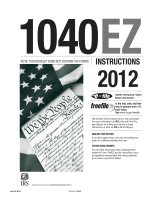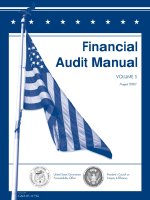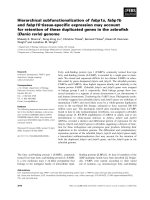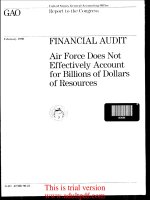FINANCIAL AUDIT Air Force Does Not Effectively Account for Billions of Dollars of Resources_part4 pdf
Bạn đang xem bản rút gọn của tài liệu. Xem và tải ngay bản đầy đủ của tài liệu tại đây (1.1 MB, 12 trang )
Chapter 3
Internal Control Weaknesses Prevent
Accurate F’inanclal Reporting and Reduce
Accountablllty Over Assets
between general ledger type control accounts and subsidiary records
and, where warranted, making the appropriate adjustments to either the
subsidiary records or to the general ledger or control accounts.
We found that reconciliations between subsidiary records and the con-
trol accounts are not always performed to ensure the accuracy and pro-
priety of recorded account balances. In addition, we found instances
where the accounting records showed that disbursements had been
made that exceeded the corresponding obligation amounts, and the Air
Force had not investigated why this occurred. Such occurrences could
indicate that disbursement information is being incorrectly recorded,
contractors are being overpaid, or the Anti-Deficiency Act is being
violated.
Con$ml Accounts Not
Reconciled With
Subsidiary Records
.
Our audit tests revealed that the control accounts were not regularly
reconciled with subsidiary records which provide the detailed support
for the summary-level data recorded in the general ledger accounts. This
occurred at three Air Logistics Centers
(ALCS),
which maintain the Air
Force’s inventories of spare parts and supplies, and at three Depot Main-
tenance Service
(DMS)
activities, which repair and maintain Air Force
equipment and weapons systems. We identified and presented the fol-
lowing discrepancies to local officials for investigation.
At Warner Robins
ALC,
one account had a negative balance of $2.1 bil-
lion, although the account balance should normally be positive or zero.
The general ledger accountant said that he had no documentation to
support the account balance and that the account had been in error
since 1983.
At the San Antonio
ALC,
subsidiary data in the Contractor Repair Inven-
tory System, which is used to control parts provided to various contrac-
tors for repair, did not agree with control account balances for materials
with contractors. During our audit, we found that the general ledger
account for materials provided to contractors was overstated by $697
million, while the account for the repair parts was overstated by $169
million. This discrepancy indicates poor control over government-owned
materials and equipment with contractors.
The Ogden
AX
general ledger included $379 million in equipment, an
amount which was also included in the
DMS
general ledger. The Air Force
requires reconciliations between these two systems in order to detect
duplications and errors, but we found that the prescribed procedures
were not followed. For example, some of the data necessary to properly
perform the reconciliations were either never considered or were
Page 37
GAO/AFMD-90-23 Air Force Financial Audit
This is trial version
www.adultpdf.com
.
Chapter 3
Internal Control Weaknesses Prevent
Accurate Nnancial Reporting and Reduce
Accountability Over Assets
recorded twice-once at the Ogden
DMS
and once at the San Antonio
DMS.
Since the reconciliations were not properly done, incorrect adjustments
to the accounts were made, simply compounding the problem.
Similar problems have been recognized in our prior reports on
DOD
agen-
cies. For example, we reported “arbitrary and erroneous reconcilia-
tions,“’ and we reported that internal controls over in-transit material at
one of the
ALCs
were inadequate because the Air Force did not reconcile
individual payments and receipts.2
Further, at two bases we visited, year-end stock fund account balances
for recording sales of inventory items to base units could not be recon-
ciled to subsidiary records generated by the supply management system.
The base units reimburse the stock fund with Operation and Mainte-
nance
(O&M)
funds, Neither we nor base officials could fully resolve
these discrepancies because necessary documentation of transactions
between the stock fund and base units had not been retained. Since the
stock funds are revolving funds and are reimbursed for sales by custom-
ers’ appropriated funds, the failure to be reimbursed in effect supple-
ments the customers’ appropriated funds improperly. Congressional
intent on use of appropriated funds is circumvented when customers
receive items from the stock funds without paying for them.
Disbursements Not
Reconciled With Obl
Balances
The Air Force Systems Command did not properly reconcile its disburse-
igation
ment transactions with supporting records of obligations as required by
Air Force regulations. Systems Command records disclosed that, as of
September 30, 1988, almost $7 billion in disbursements was not recon-
ciled with obligation records, Reconciliations of disbursement transac-
tions to supporting records of obligations are essential to monitoring and
controlling contractor payments and ensuring compliance with the Anti-
Deficiency Act. The act provides that no officer or employee-of the
United States shall make or authorize an expenditure from or create or
authorize an obligation under any appropriation or fund in excess of the
amount available therein (31 USC. 1341). The act also provides that no
officer or employee of the United States shall authorize or create any
obligation or make any expenditure in excess of an apportionment or in
excess of the amount permitted by regulation (31 USC. 1517).
‘Navy’s Progress in Improving Physical Inventory Controls and the Magnitude, Causes, and Impact of
Inventory Record Inaccuracies in the Army, Air Force, and Defense Logistics Agency
(GAO/
NSIAD849
_ _
, November 4,1983).
“Inventory Management: Receipt Confirmation Problems (GAO/NSIAD-88-79, July 14, 1988).
Page 38
GAO/AFMDSO-23 Air Force Financial Audit
This is trial version
www.adultpdf.com
Chapter 3
Internal Control Weaknesses Prevent
Accurate Fln~clal Reporting and Reduce
Accountability Over Assets
The Systems Command awards contracts while other organizations (for
example, the Army, Navy, and Defense Contract Administration Ser-
vices) are responsible for making the actual payments to contractors.
The organization making the actual payments then provides payment
information to the Air Force Accounting and Finance Center, which ver-
ifies the information and forwards it to Systems Command. Both the
payment office and Systems Command are responsible for ensuring that
the payments do not exceed the obligations and that correct appropria-
tions are charged. The Systems Command either accepts the transac-
tions if they are found to be for proper disbursements or it rejects and
returns them to the Finance Center if they are deemed improper.
Acceptance requires the Systems Command to match the disbursements
with the related obligations and to notify the Finance Center that the
transactions are accurate and proper.
Reconciliations are a key control in ensuring that payments do not
exceed obligations on contracts and that funds are properly spent. When
payments exceed obligations (also referred to as negative unliquidated
obligations), management needs to initiate immediate corrective action.
These issues are discussed in our recent report,3 which recommended
that negative unliquidated obligations already recorded be resolved and
that quarterly reports on the amount and age of the negative unliqui-
dated obligations be submitted to management.
Account Balances
Cohtain Unsupported,
Arbitrary
Adjustments
Title 2 requires that documentation of transactions and other significant
events, including adjustments to accounting records, be complete and
accurate so that transactions and related information can be traced from
their initiation, through their processing, to their completion. Compli-
ance with this standard requires that documentation be purposeful and
useful to managers and auditors involved in analyzing operations. Air
Force regulations also require that adjustments be adequately
documented.
We found that adjustments totaling billions of dollars were made to
account balances and records throughout fiscal year 1988. We did not
find records to adequately document the purpose of many of these
adjustments, and Air Force officials could not provide a reasonable
explanation for them.
3Financial Management: Air Force Records Contain $612 Million in Negative Unliquidated Obligations
(GAO/AFMD 89 78
_ -
, June 30,198Q).
Page 39
GAO/AFMD-90-23 Alr Force Financial Audit
This is trial version
www.adultpdf.com
Chapter 3
Int.emal Control Weaknesses Prevent
Accurate Financial Reporting and Reduce
Accountability Over Assets
There are legitimate and necessary reasons for making adjustments to
accounting records, such as correcting errors, posting accruals to recog-
nize expenses and related liabilities, or writing off assets which are no
longer of value. However, without adequate safeguards, adjustments to
accounting records could also be used for any number of illegitimate or
improper purposes, such as covering up defalcations, hiding losses of
assets, or masking errors. Accordingly, from an internal control stand-
point, it is essential to establish internal controls which ensure that only
legitimate, authorized adjustments are made and that clear documenta-
tion is maintained to explain their basis and purpose. Such documenta-
tion allows for detection and systematic correction of errors and
establishes that adjustments were made for a valid purpose and were
authorized and executed by personnel acting within the scope of their
authority.
Our audit work revealed that many significant adjustments to account-
ing records appeared incorrect, were of questionable purpose, and were
not documented. Because of the lack of documentation, we could not
determine whether these adjustments were appropriate or whether the
affected account balances were accurately stated. Air Force officials
could not explain these adjustments.
Our audit tests of adjustments revealed that certain undocumented
adjustments were made to force control accounts and subsidiary records
to agree, as shown in the following examples:
.
The control accounts in the Space Systems Division’s trial balance for
March 31, 1988, differed from its subsidiary records by $2.4 billion. To
get the two systems to agree, an adjustment was made which charged
the difference to the subsidiary system. The effect of this adjustment
was to reduce assets and decrease the Other Operating Gains and Losses
account. However, Space Systems Division officials could not provide
documentation to support the adjustment, nor could they explain how
the difference between the trial balance and subsidiary records arose.
Simply masking discrepancies is not a proper use of adjustments.
l
At Sembach Air Force Base, we found over $214,000 in undocumented
adjustments that were apparently made to force the control accounts to
agree with subsidiary records. These adjustments were charged to a sus-
pense account designed to identify transactions which need to be
reviewed. When management uses suspense accounts (accounts with
transactions that have not yet been classified for posting to their proper
accounts), it should also institute controls over the transactions entered
into these accounts to ensure that they are promptly classified and
Page 40
GAO/AFMLI-90-23 @ Force Financial Audit
This is trial version
www.adultpdf.com
Chapter 3
Int4wnal Control Weaknesses Prevent
Accurate Fbmncial Reporting and Reduce
Accountability Over Assets
removed from the suspense accounts on a timely basis. However, we
noted several examples where suspense accounts were not being prop-
erly used at Sembach. For example, an unsupported adjustment of
$82,000 was made during fiscal year 1988 to force the fuels inventory
control account to agree with subsidiary records. Some of the unsup-
ported adjustments were attributed to the actions of a disgruntled
employee in the finance office who failed to properly process transac-
tions, entered erroneous data into the materiel accounting system, and
destroyed source documents. An investigation is under way to determine
if any fraud occurred.
. At the Systems Command, our audit tests disclosed unsupported adjust-
ments of $600,000 that were made to obligation and expenditure
accounts for Operations and Maintenance appropriations in September
1988. Officials could not explain the adjustments, nor could they find
any documentation to show why they were made.
l
At the three
Au3
we reviewed, the interfaces between the perpetual
inventory tracking systems and inventory accounting system did not
function properly. As a result, the two systems reported different
amounts on hand for the same items. To compensate, either each month
or each quarter, the accounting and finance office adjusted the accounts
in the inventory accounting system to force them to agree with the per-
petual inventory tracking system’s balances. However, the discrepancies
between the systems were not researched to determine their causes. The
net effect of such adjustments for fiscal year 1988 decreased the inven-
tory accounts by about $361 million. At our request, Ogden
ALC
officials
researched $241 million of its September 30, 1988, adjustment and
found that $114 million was the result of inventory system errors, while
$127 million resulted from coding and timing errors. These errors had
been masked by the improper adjustments and would not likely have
been detected had we not asked base officials to investigate.
Air Force regulations require that supervisors and managers review and
approve all adjustments. However, many of the adjustments discussed
above were not provided to higher levels of management for their
review and approval. Not submitting adjustments for review and
approval circumvents essential internal controls and could allow adjust-
ments to be used to hide errors, fraud, or misuse of assets.
Other InterQal Control
Our review disclosed several other internal control weaknesses that
Weaknesses
were significant to particular organizational levels within the Air
Force’s management structure but not pervasive to the Air Force. We
Page 41
GAO/AFMD-90-23 Air Force Financial Audit
This is trial version
www.adultpdf.com
Chapter 3
Inted Control Weaknesses Prevent
Accurate Financial Reporting and Reduce
Accountability Over Assets
discuss these problems in more detail and make recommendations to cor-
rect the problems in separate reports evaluating the internal controls at
(1) base-level operations, (2) Systems Command operations, (3) Air
Logistics Centers, and (4) Depot Maintenance Services, Air Force Indus-
trial Fund.
-’
Weabnesses Found in
BashLevel Operations
.
.
Internal control weaknesses contributed to the inaccuracy of financial
reporting by the base-level general accounting and finance system. We
found the following conditions during our review of base-level
operations.
Reconciliation of civilian payroll and personnel master records is not
performed. At the Air Force District of Washington, the payroll office
had not reconciled its records to personnel records since May 1986. This
reconciliation is the primary control to ensure that civilian employees
are paid as authorized by the base personnel office, This comparison
serves to identify any errors or irregularities such as improper pay rates
or fictitious employees.
Discrepancies in shipments of materials are not always researched.
Internal controls to ensure proper recording of goods shipped to bases
are not always performed. Follow-up listings which are used to prompt
follow-up for missing or damaged goods are not always prepared. Addi-
tionally, when the follow-up listings are prepared, required reports
which document resolution of the discrepancy are not always produced.
Weak controls over shipments could result in the Air Force’s paying for
defective items or goods it does not receive.
We determined that the Air Force bases do not consistently report con-
struction-in-process. During construction of, or improvement to, base
facilities, the bases should periodically recognize as assets the construc-
tion performed or improvements made. This is accomplished by record-
ing the appropriate amounts as “construction-in-process.” At three of
nine bases tested, construction-in-process was not properly recorded.
At one base, the construction of a new aircraft hangar was not recorded
in the base property records. According to the real property officer, the
base does not routinely account for costs associated with construction-
in-process unless the Air Force acts as the construction agent. According
to a contracting officer, failure to record construction-in-process in the
accounts caused an understatement of assets of at least $39 million.
Page 42
GAO/AFMD-90-23 Air Force Financial Audit
This is trial version
www.adultpdf.com
Chapter 3
Intemal Control Weaknesses Prevent
Accurate! Flnanclal Reporting and Reduce
Accountability Over Assets
Conversely, recording unfinished construction, or improvements, in the
completed building account overstates building cost and depreciation
before the useful life of the building commences. One of the bases tested
had seven facilities under construction as of September 30, 1988, with a
cost at that time of $8.6 million. The base prematurely recorded these
facilities in the completed buildings account at an estimated completion
cost of $16.4 million, thus overstating assets by about $7.9 million.
Once construction has been completed, the associated costs should be
moved from the construction-in-process account to the completed facili-
ties account. At one base, we found that a completed project for $79,960
had been recorded in the completed building account. However, the cost
of the project had not been removed from the construction-in-process
account, thus causing an overstatement of that amount.
Weaknesses Found at
Systems Command
.
.
.
Our tests of the authorization, approval, and financial reporting for con-
tracts to acquire major weapons systems showed that budget authority
and obligation and expenditure transactions were not recorded
promptly. When these transactions are not recorded in a timely manner,
managers receive incomplete financial information. This same informa-
tion is then used to determine if funds are available for other procure-
ment actions, The result is that managers are then more likely to
commit, obligate, and expend more funds than were authorized for a
program or contract.
Budget authority: The Electronic Systems Division
(ESD)
requires budget
authority to be recorded in
GAFS
within 3 days of receipt of the source
documents. We found that 362 of the 657 budget authority entries were
not recorded within 3 days, and 262 of the transactions were not
recorded within 7 days.
Obligations:
ESD
requires obligations to be recorded within 5 calendar
days of receipt. We found 100 of 165 obligations we tested were not
recorded within 5 days. Further, 30 of the obligations were posted
between 11 and 20 days after receipt, and 24 were recorded over 21
days after receipt. Similarly, the Space Systems Division requires obliga-
tions to be recorded within 7 days, and we found that 71 of the 202
obligations we tested were not recorded within the 7 days.
Expenditures: Neither the Air Force Systems Command nor the Air
Force had criteria for the number of days it should take for expendi-
tures to be recorded. We reviewed a total of 278 expenditures at three
product divisions and the Rome Air Development Center and found that
214 were not posted within 10 days.
Page 43
GAO/AFMD-90-23 Air Force Financial Audit
This is trial version
www.adultpdf.com
Chapter 3
Intemal Control Weaknesses Prevent
Accurate F’luauclal Reportlug and Reduce
Accountability Over Assets
The late posting of commitments and obligations affects the accuracy of
Air Force Systems Command’s financial reports-available funding
could be overstated. To the extent that program managers rely on these
financial reports to commit and obligate funds for procurements, the
inaccurate reports would cause them to misinterpret the amount of
funds available and exceed a contract’s obligational authority.
Wedknesses Found at Air
Logistics Centers
.
.
Based on audit work performed, we found the following weaknesses at
the
ALCS:
Inventory adjustments are not timely. The Air Force Logistics Command
regulations require that any adjustment or correction to inventory
records be made within 21 days. However, we noted at the Ogden
ALC
that over 10 percent of the adjustments we reviewed exceeded the crite-
ria, with processing times ranging from 23 to 113 days. Accurate
records of inventory quantities on hand are critical for maintaining
readiness. Good internal control would alert management to any adjust-
ments which were not promptly made.
Disbursements are not recorded on a timely basis by
ALCS.
Financial
reports issued and used by the
ALCS
misstated the status of central pro-
curement funds by hundreds of millions of dollars. We found time lags
of up to 492 days from the date that contract administrators paid a con-
tractor until the
ALCS,
which are responsible for contract funding,
learned of the disbursement. The significant overstatement of unliqui-
dated obligations in these reports is potentially misleading for those Air
Force managers who use the data in making decisions on resource allo-
cation. At the San Antonio
ALC,
we studied 75 disbursements reported
from the Army, Navy, or another Air Force base. We found that it took
from 96 to 230 days for San Antonio to receive data on 63 of the trans-
actions. It took from 303 to 492 days before San Antonio was notified of
the other 12. There were similar occurrences at the Ogden
ALC,
with time
lags ranging from 118 to 385 days.
Weaknesses Found at
Depot Maintenance
Services
Managers must strengthen controls relating to the issuing and account-
ing for materials and for the accountability, depreciation, and disposal
of equipment used in the repair of items at depots. Current controls do
not ensure proper safeguarding of these materials and equipment or the
proper reporting of the results of the Depot Maintenance Services’
operations.
J
Page 44 GAO/AFMD-90-23 Air Force Financial Audit
This is trial version
www.adultpdf.com
Chapter 3
Internal Control Weaknesses Prevent
Accurate Financial Reporting and Reduce
Accountablllty Over Assets
l
Controls over material costs. Controls over the $613 million of material
costs incurred by
DMS
during fiscal year 1988 did not (1) ensure that
material was charged to the correct job or (2) limit material quantity
issues to actual job requirements. As a result, the
DMS
could be issuing
materials in excess of those needed for its repair functions, and material
costs for specific jobs may not be correctly reported. For good internal
control, the
DMS
should know how much material each type of job
requires. The Air Force reported the failure to limit material quantities
to actual job requirements as a control weakness in its
FMFLA
report for
fiscal year 1988.
. Controls over equipment. Our testing over the acquisition, transfer,
depreciation, and disposal of industrial equipment disclosed (1) errone-
ous posting to equipment accounts, (2) incorrect adjusting entries, (3)
unrecorded equipment, and (4) facility costs misclassified as equipment
costs. As a result, the financial data and reports are not accurate or reli-
able, and accountability for equipment is not effectively maintained.
In addition, as of February 20, 1990, we were still awaiting the Air
Force’s response to our December 21, 1989, inquiry concerning several
issues identified during our audit. Specifically, we have asked the Air
Force to explain its authority to transfer $76.5 million of fiscal year
1988 Operations and Maintenance appropriated funds to
DMS
and to
fund certain military construction work with
DMS
funds.
On November 12, 1984, a building at the Oklahoma City
AX
was exten-
sively damaged by fire. On August 27, 1985, about $76.5 million of fiscal
year 1985
O&M
funds were “passed through” to
DMS
for fire costs. The
transfer converted $76.5 million of
O&M
funds available for fiscal year
1985 to
DMS
funds with no fiscal year constraints. The Air Force may
transfer funds between
O&M
and
DMS
under statutory authority included
in each Defense Appropriations Act if certain prescribed procedures are
followed. Since we are not aware that the Air Force followed the proce-
dures for transfer when the $76.5 million was transferred to
DMS,
the
transfer may have been improper.
Our audit also identified about $24.5 million of
DMS
funds which were
used to finance six line-items in a contract to restore the
DMS
facilities
damaged by the fire. These items ranged in estimated prices from
$400,000 to $10.6 million. The work represented by these items may
have been a military construction project which had to be financed from
military construction appropriations rather than from
DMS.
A military
construction project consists of all military construction work necessary
to produce a complete and usable facility or an improvement to an
Page 46
GAO/AFMD-90-23 Air Force Financial Audit
This is trial version
www.adultpdf.com
Chapter 3
Internal Control Weaknesses Prevent
Accurate Fiuancial Reporting and Reduce
Accountability Over Assets
existing facility (10 USC. 2801). A military construction project which
costs more than $1 million generally must be specifically authorized by
law (10 USC. 2802). Such projects may also be carried out by the Air
Force under statutory authorities to conduct emergency construction
(10 USC. 2803) or to restore facilities which are lost or damaged (10
U.S.C. 2854). However, emergency and restoration projects under these
authorities which cost more than $1 million must be financed out of the
military construction appropriation. Our review of the work financed by
the $24.5 million in
DMS
funds indicates that restoration may have been
a military construction project costing more than $1 million. If so, the
Air Force may have carried out an unauthorized military construction
project and may have improperly funded the project with
DMS
funds.
I
I
Cocclusions
Effective financial management requires strong systems of internal con-
trols to help ensure the integrity and reliability of financial information,
to safeguard assets, and to promote conformity with proper operating
procedures. Although Air Force management is responsible for main-
taining a system of internal controls, including accounting controls, our
review identified pervasive control weaknesses, such as not routinely
reconciling account balances and adjusting account balances without
adequate support or documentation. We also identified a number of con-
trol weaknesses that were significant to specific organizational levels
within the Air Force. In many cases, these weaknesses resulted from
noncompliance with Air Force regulations.
The Air Force is not alone, however, in its failure to attain a sound inter-
nal control environment. Our recent report illustrates the seriousness of
the internal control and accounting system problems encountered in the
federal government in recent years and the need for a vigorous program
to correct these problems.4
Recommendations
We recommend that the Secretary of the Air Force direct the Chief
Financial Officer to
l
report the internal control problems with reconciliations and documen-
tation for adjustments in
FMFIA
reports to the Secretary of Defense;
l
reconcile subsidiary records periodically to the control accounts and cor-
rect errors and weaknesses;
Page 46
GAO/AFMD-90-23 Air Force Financial Audit
This is trial version
www.adultpdf.com
Chapter 2
Wmnal Control Weaknesses Prevent
Accurate Financial Reporting and Reduce
Accountability Over Assets
. reconcile disbursements with obligations and promptly correct errors;
. document all adjustments to subsidiary records and control accounts;
l
enforce Air Force’s requirement that supervisors and managers review
and approve all significant adjustments; and
. report unsupported adjustments and reconciliation internal control
problems, if applicable, in future
FMFIA
reports.
Agdncy Comments
DOD
concurred with the recommendations presented above.
Page 47 GAO/AJ?MD-90-22 Air Force Financial Audit
This is trial version
www.adultpdf.com





![Financial Audit Manual [This page intentionally left blank.] ppt](https://media.store123doc.com/images/document/14/rc/rq/medium_QwDzJhAwHp.jpg)



